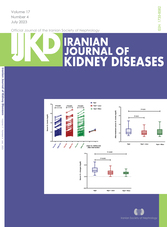Correlation Between Serum Homocysteine Levels and Carotid Intima-media Thickening in Hemodialysis Patients
Abstract
ntroduction. Hyperhomocysteinemia is an important risk factor for cardiovascular disease in ESKD patients. Homocysteine, as an inflammatory factor, and carotid intima-media thickness (CIMT) could predict atherosclerosis in hemodialysis-treated ESKD patients. In this regard, the present study was conducted to investigate serum homocysteine level and its relationship with internal carotid intima thickness in ESKD patients undergoing routine hemodialysis. Methods. This study comprised 56 ESKD patients, older than 40 years, undergoing hemodialysis for at least 1 year. All participants were taking Nephrovit for at least 6 months. The study participants were patients who underwent ultrasonography for CIMT determination and laboratory test Results. There was no statistically significant relationship between the mean homocysteine level and hypertension, diabetes mellitus, duration of dialysis, and body mass index (BMI). Among the study participants, the results also showed that the mean value of CMIT homocysteine and C-reactive protein (CRP) were 0.89 millimeters, 30.44 (mcmol/L), and 35.60 mg/L; respectively. Despite hypertension, there was a significant difference between the mean values of CMIT in patients with diabetes mellitus and those who had been on dialysis for a longer period (more than 3 years). Also, the mean value of CMIT was significantly higher in obese patients than those with normal BMI. None of the other variables including homocysteine serum level, C-reactive protein (CRP), and CMIT showed a significant correlation. Conclusion. The results of the study suggest that there is no relationship between serum homocysteine level and carotid intima-media thickness in hemodialysis patients.
DOI: 10.52547/ijkd.7424
Downloads
Download data is not yet available.
Downloads
Published
2023-08-24
Issue
Section
ORIGINAL | Dialysis
How to Cite
Correlation Between Serum Homocysteine Levels and Carotid Intima-media Thickening in Hemodialysis Patients. (2023). Iranian Journal of Kidney Diseases, 17(4), 222-227. https://ijkd.org/index.php/ijkd/article/view/7424


